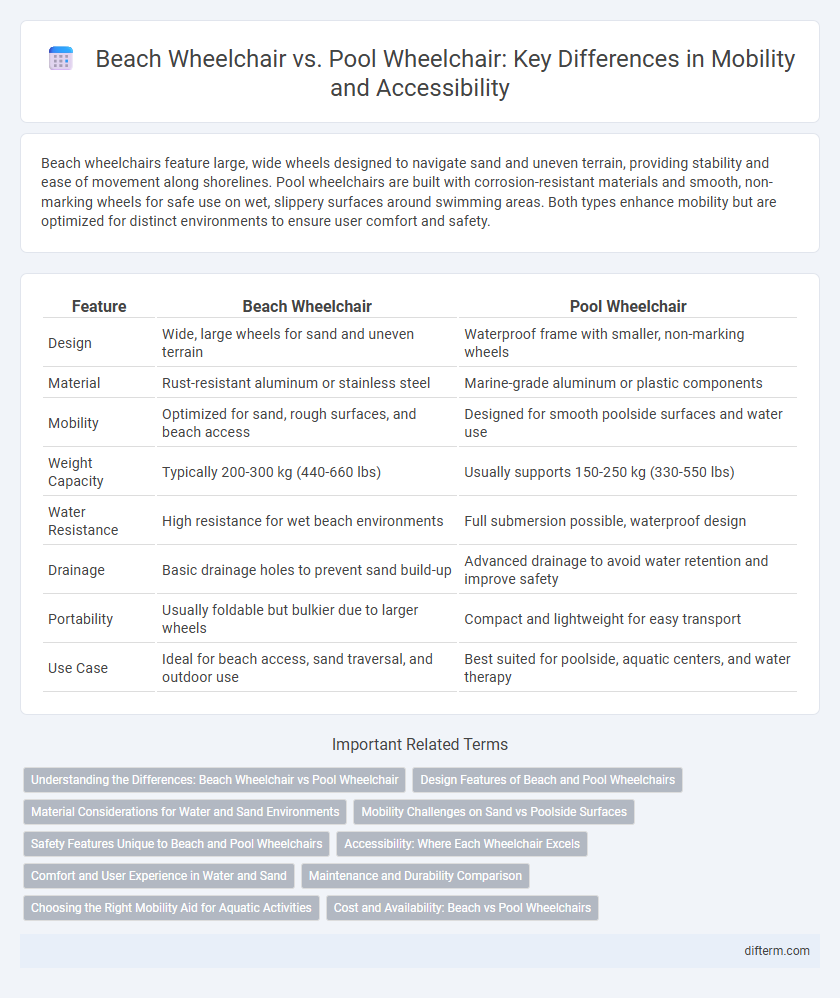Beach wheelchairs feature large, wide wheels designed to navigate sand and uneven terrain, providing stability and ease of movement along shorelines. Pool wheelchairs are built with corrosion-resistant materials and smooth, non-marking wheels for safe use on wet, slippery surfaces around swimming areas. Both types enhance mobility but are optimized for distinct environments to ensure user comfort and safety.
Table of Comparison
| Feature | Beach Wheelchair | Pool Wheelchair |
|---|---|---|
| Design | Wide, large wheels for sand and uneven terrain | Waterproof frame with smaller, non-marking wheels |
| Material | Rust-resistant aluminum or stainless steel | Marine-grade aluminum or plastic components |
| Mobility | Optimized for sand, rough surfaces, and beach access | Designed for smooth poolside surfaces and water use |
| Weight Capacity | Typically 200-300 kg (440-660 lbs) | Usually supports 150-250 kg (330-550 lbs) |
| Water Resistance | High resistance for wet beach environments | Full submersion possible, waterproof design |
| Drainage | Basic drainage holes to prevent sand build-up | Advanced drainage to avoid water retention and improve safety |
| Portability | Usually foldable but bulkier due to larger wheels | Compact and lightweight for easy transport |
| Use Case | Ideal for beach access, sand traversal, and outdoor use | Best suited for poolside, aquatic centers, and water therapy |
Understanding the Differences: Beach Wheelchair vs Pool Wheelchair
Beach wheelchairs feature large, wide tires designed to easily navigate sandy and uneven terrain, while pool wheelchairs have smooth, water-resistant materials and smaller wheels optimized for use on wet, flat surfaces. Beach models prioritize stability and traction for outdoor environments, whereas pool wheelchairs emphasize corrosion resistance and maneuverability in aquatic settings. Selecting the appropriate wheelchair depends on specific mobility needs and the intended environment, ensuring comfort and safety.
Design Features of Beach and Pool Wheelchairs
Beach wheelchairs feature large, wide tires designed for navigating sand and uneven terrain, providing stability and ease of movement on the beach. Pool wheelchairs incorporate rust-resistant materials, such as stainless steel or aluminum, and have non-marking wheels suited for wet surfaces and easy maneuverability in and around pools. Both types prioritize user comfort and safety but are tailored specifically to the unique environmental challenges of beach and pool settings.
Material Considerations for Water and Sand Environments
Beach wheelchairs are typically constructed with corrosion-resistant aluminum frames and large, wide polyurethane or balloon tires designed to navigate soft sand without sinking, ensuring durability in salty and abrasive environments. Pool wheelchairs often feature stainless steel or rust-proof coated frames with smaller, non-marking rubber tires optimized for smooth surfaces and constant water exposure in chlorinated pools. Material selection directly impacts functionality, longevity, and user safety in distinct aquatic and sandy mobility settings.
Mobility Challenges on Sand vs Poolside Surfaces
Beach wheelchairs feature large, wide tires designed to navigate uneven, soft sand, providing stability and ease of movement on challenging beach terrain. Pool wheelchairs prioritize water-resistant materials and smooth-rolling casters for maneuverability on wet, slippery poolside surfaces. Addressing mobility challenges requires selecting a wheelchair tailored to the specific environment to ensure safety and independence.
Safety Features Unique to Beach and Pool Wheelchairs
Beach wheelchairs feature oversized, corrosion-resistant wheels designed to navigate uneven sand terrain safely, preventing tipping and entrapment. Pool wheelchairs incorporate non-slip, water-resistant materials with rust-proof frames and secure drainage systems to enhance user stability and hygiene. Both types prioritize safety by integrating specialized components tailored to their respective environments, minimizing accident risks.
Accessibility: Where Each Wheelchair Excels
Beach wheelchairs excel in navigating sandy terrain with large, wide tires and rust-resistant frames designed for outdoor use, providing users with enhanced accessibility along shorelines and uneven surfaces. Pool wheelchairs feature non-marking, water-resistant wheels and materials optimized for smooth maneuverability on wet, slippery pool decks, ensuring safety and ease of use in aquatic environments. Each wheelchair is engineered to maximize accessibility by addressing the specific challenges of their respective settings--beach or pool.
Comfort and User Experience in Water and Sand
Beach wheelchairs feature wider, puncture-resistant tires designed for smooth navigation over sand, enhancing user comfort by preventing sinking and providing stability. Pool wheelchairs prioritize corrosion-resistant materials and non-marking wheels for safe movement on wet surfaces, ensuring a secure and comfortable experience in and around water. Both types emphasize ergonomic seating and support, tailored respectively to the challenges of either sandy terrain or slippery pool environments, optimizing overall user experience.
Maintenance and Durability Comparison
Beach wheelchairs are constructed with corrosion-resistant materials like stainless steel and heavy-duty plastics to withstand saltwater exposure and abrasive sand, requiring minimal maintenance to prevent rust and wear. Pool wheelchairs often feature lightweight aluminum frames designed for frequent water immersion, necessitating regular cleaning and drying to maintain durability and prevent corrosion. Both types incorporate specialized tires and components tailored to their environments, but beach wheelchairs typically demand more robust maintenance routines due to harsher outdoor conditions.
Choosing the Right Mobility Aid for Aquatic Activities
Beach wheelchairs feature large, wide wheels designed to navigate sand and uneven terrain, providing increased stability and mobility on the beach. Pool wheelchairs are made from corrosion-resistant materials like aluminum or marine-grade stainless steel, with smooth, non-marking wheels optimized for wet, slippery pool surfaces. Selecting the right mobility aid depends on the primary environment--beach wheelchairs suit outdoor, sandy conditions, while pool wheelchairs ensure safety and maneuverability in aquatic centers.
Cost and Availability: Beach vs Pool Wheelchairs
Beach wheelchairs typically cost more than pool wheelchairs due to specialized features like large, balloon tires and corrosion-resistant materials, designed for sandy and rough terrains. Pool wheelchairs are generally more affordable and widely available, featuring materials suitable for water exposure but lacking the rugged build needed for beach use. Availability of beach wheelchairs is limited in comparison, often rented at specific coastal locations, while pool wheelchairs are commonly found in public swimming facilities and healthcare centers.
beach wheelchair vs pool wheelchair Infographic

 difterm.com
difterm.com